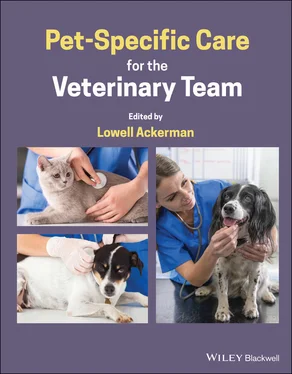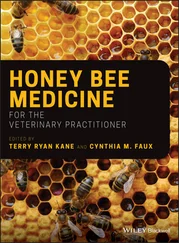3.12.3.2 Palpation and ROM
At each wellness exam, make it a part of the general physical exam to look at, palpate, and do a quick ROM evaluation of each of the patient's joints. Any abnormalities detected or suspected based on this quick assessment can be discussed with the client and further evaluated specifically.
While force plate analysis isn't available in most veterinary practices, thanks to the prevalence of smartphones, we all now typically have a rather powerful tool to help in our regular gait analyses of patients. When orthopedic or gait abnormalities are suspected, take slow‐motion video using a smartphone to help in the evaluation and to show clients any abnormalities found. You can also have your client use their phone to shoot slow‐motion video of their pets going up and down stairs, running, jumping, and doing other activities at home. Not only can this help you find and localize orthopedic disorders but, by using “before” and “after” videos, it can also help you and your clients appreciate any improvements with therapies instituted. Tip: When shooting these videos, ensure that the phone is held horizontally, in “landscape” mode, and that the lighting and background provide the right detail and contrast to get the most benefit from the videos.
While dedicated radiographs for orthopedic disease screening generally require and benefit from sedation or anesthesia (e.g., Penn HIP, etc.), don't forget about the orthopedic information that can be gleaned from general radiographs of patients when looking for thoracic or abdominal disease. Shoulders and hips are almost always present in thoracic and abdominal radiographic views, respectively, and elbows and stifles frequently are, too. Similarly, vertebral bodies and associated intervertebral disc spaces are also frequently present for evaluation. While thoracic and abdominal views and techniques aren't specific for evaluating joints, you can still glean a lot of initial screening information from their appearance in them. It is important to realize that all pets can develop orthopedic issues, including mixed‐breeds, and so routine screening is important for all patients.
Common orthopedic disorders, such as hip and ED, patella luxation, and even cruciate disease, have been shown to have a heritable component. However, because the heritability of these conditions is complex (involving multiple mutations), truly predictive and cost‐effective genetic screening isn't yet available (see 3.4Predicting and Eliminating Disease Traits). This is an exciting area that holds good promise for future development. In the interim, it is important to recommend routine orthopedic screening of pets with known breed predispositions to such problems (see 3.11Integrating Genotypic and Phenotypic Testing).
3.12.4 Incorporating Orthopedic Screening into Your Practice Workflow and Client Recommendations
Several suggestions for incorporating orthopedic screening into exams and practice workflows are mentioned above. Here are a few more ways to recommend and incorporate screening and monitoring of orthopedic conditions into daily practice.
Based upon each pet's age, breed, history, and other signalment and risk factors, preplan and include orthopedic screening and monitoring radiographs into each predisposed pet's long‐term care plan (see 1.3Personalized Care Plans). Be especially forthcoming in your recommendations for these radiographs in pets that fit any of the following criteria.Overweight or obesePredisposed breedWorking dog or athletePets that are exhibiting behavioral changes, including new aggression, decreased interaction with clients, and those exhibiting new noise aversions [5]Cats with inappropriate toileting
So long as they are stable, take advantage of any pet sedated or anesthetized for procedures (e.g., spay/neuter, dental prophylaxes, ear cleanings, laceration repairs, etc.) to do a deeper, more thorough palpation and ROM testing of joints. Since it's good practice for you and also may turn up otherwise undiagnosed conditions (providing better medicine and improving comfort for your patients, and revenue generation for your practice), do these deeper orthopedic evaluations as value‐added, no‐charge components of your sedated/anesthetized procedures on all patients. However, be sure to include a section on your estimates and sedation/anesthesia consent forms offering and recommending that, so long as their pet is stable under sedation/anesthesia and based on your findings and their pet's risk factors, specific orthopedic radiographs may be recommended. Provide an estimate for such and get the owner's authorization for such in advance.
 EXAMPLES
EXAMPLES
Dr X loved orthopedics and made it a habit of practicing his drawer testing on anesthetized patients. Max, a 5‐year‐old neutered male Labrador, was in for dental prophylaxis. While Max was under anesthesia for his dental, Dr X thought he appreciated a little more laxity in Max's right stifle. He contacted Max's owner to report his concerns and recommend stifle radiographs. The owner had been advised of this possibility prior to the procedure, based on Max's breed predisposition, and consented. The radiographs were sent off for interpretation and a partial cruciate tear was suspected based on the clinical history, physical exam findings, and radiographic appearance of Max's stifles. Max's owners were counseled on weight management and Max was started on a daily joint supplement and fish oils. A referral was also made to a local veterinary physiotherapy center to aid in his weight loss and to help stabilize his stifles as much as possible. With this early detection and intervention, Max remained stable and never required cruciate surgery.
 TAKE‐AWAYS
TAKE‐AWAYS
Whether they develop early in life or late, orthopedic disorders can cause significant pain, dysfunction, and decreased QOL for our veterinary patients, as well as significant financial, logistical, and emotional distress for our clients.
Across the board, serious orthopedic disorders are going undiagnosed and therefore untreated and managed, often to the detriment of our patients, clients, and even our own businesses.
Proactive education, screening, and appropriate interventions should be the standard of care, as they benefit all stakeholders (patients, clients, and practices).
Radiography isn't the only method available for orthopedic disease screening in veterinary patients.
Take advantage of any sedated or anesthetized pets to do additional screening for orthopedic conditions, with owner consent.
 MISCELLANEOUS
MISCELLANEOUS
References
1 1 Breed Statistics. www.ofa.org/diseases/breed‐statistics
2 2 Mills, D. (2014). Prevalence of Osteoarthritis in Dogs Undergoing Routine Dental Prophylaxis. Presented at the World Small Animal Veterinary Association World Congress, Cape Town, South Africa, September.
3 3 University of Glasgow. Cats Do Suffer From Arthritis, Study Shows. ScienceDaily. www.sciencedaily.com/releases/2007/08/070824215618.htm
Читать дальше

 EXAMPLES
EXAMPLES TAKE‐AWAYS
TAKE‐AWAYS MISCELLANEOUS
MISCELLANEOUS










